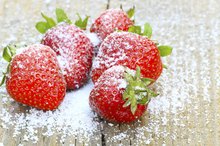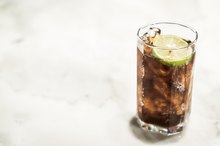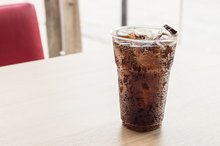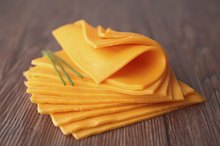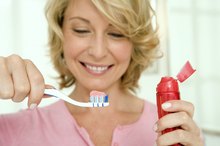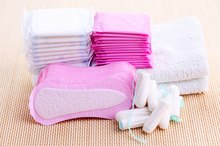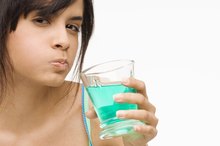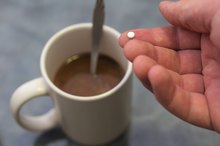Saccharin Safety in Toothpaste
Saccharin, a petroleum-based sugar substitute, is used in soft drinks, diet food and personal hygiene products such as lip balm and toothpaste. Saccharin was linked to cancer in clinical studies in the 1970s, but it continues to be used as a food and hygiene product additive, including for use in sweetening toothpaste.
Toothpaste Ingredients
Toothpaste composition is dependent on the type of toothpaste and the manufacturer. Wetting and flavoring agents are common additives. Acesulfame-K, sucralose, aspartylphenylalanine methyl ester, alitame and tagatose are in the same class of sweetener as saccharin, but saccharin sodium is less expensive to produce. All of these products are added to toothpaste during the manufacturing process.
- Toothpaste composition is dependent on the type of toothpaste and the manufacturer.
- All of these products are added to toothpaste during the manufacturing process.
Saccharin Standards
Stevia & the Atkins Diet
Learn More
The United States International Trade Commission (USITC) defines saccharin as "a non-nutritive sweetener used in beverages and foods, personal care products such as toothpaste, table top sweeteners and animal feeds." Saccharin is manufactured from petroleum products and was first made in 1879, although it was not used as a sugar substitute until 1885. It is approximately 350 times sweeter than sugar, according to the USITC, and is commonly added to lip balm, mouthwash and toothpaste. Food-grade saccharin must meet standards established by the FDA in the Food Chemical Codex and U.S. Pharmacopeia, according to the USITC.
- The United States International Trade Commission (USITC) defines saccharin as "a non-nutritive sweetener used in beverages and foods, personal care products such as toothpaste, table top sweeteners and animal feeds.
- " It is approximately 350 times sweeter than sugar, according to the USITC, and is commonly added to lip balm, mouthwash and toothpaste.
Toothpaste Trends
A report by Research and Markets on "Oral Hygiene in the United States 2009" outlined sales reports for toothpaste, citing an increase in sales of "inexpensive private-label options." The private-label, low-priced products are more likely to include saccharin as an artificial sweetener. The research company predicted an increase in the low-end tooth preparations due to "recessionary effects" in the economy. Tom's of Maine, Inc. toothpaste products, introduced in 1975 during the height of the saccharin link with cancer reporting, is manufactured without the addition of any artificial ingredients and without saccharin. Tom's accounted for the largest sales of natural toothpaste in the U.S. in 2009.
- A report by Research and Markets on "Oral Hygiene in the United States 2009" outlined sales reports for toothpaste, citing an increase in sales of "inexpensive private-label options.
- " The research company predicted an increase in the low-end tooth preparations due to "recessionary effects" in the economy.
Studies
Side Effects of Sugar Substitutes
Learn More
The U.S. Food, Drug and Cosmetic Act's Delaney Clause prohibits the use of "any food additive that has been shown to cause cancer when ingested by humans or animals." Tests were ordered to assess a potential link between cancer and saccharin. "The Cancer Testing Technology and Saccharin" report, published in 1977 by the Board of the Office of Technology Assessment, reviewed saccharin tests and reported no link between bladder cancer in human males and use of artificial sweeteners. A Canadian study reported after the U.S. study did find a link between the two. Both studies were done on a limited number of participants (only 632 in the Canadian study), and both were limited to studying only a correlation to bladder cancer.
- The U.S. Food, Drug and Cosmetic Act's Delaney Clause prohibits the use of "any food additive that has been shown to cause cancer when ingested by humans or animals."
- The Cancer Testing Technology and Saccharin" report, published in 1977 by the Board of the Office of Technology Assessment, reviewed saccharin tests and reported no link between bladder cancer in human males and use of artificial sweeteners.
Expert Insight
The U.S. National Institutes of Health National Cancer Institute states that studies of saccharin "have not provided clear evidence of an association with cancer in humans." Studies of humans, as opposed to rats, have not provided "consistent evidence that saccharin is associated with bladder cancer incidence," according to the Institutes.
Related Articles
References
- U.S. Food & Drug Administration. Additional information about high-intensity sweeteners permitted for use in food in the United States. Updated February 8, 2018.
- The National Cancer Institute. "Artificial Sweeteners and Cancer." https://www.cancer.gov/about-cancer/causes-prevention/risk/diet/artificial-sweeteners-fact-sheet.
- Touyz LZ. Saccharin deemed "not hazardous" in United States and abroad. Curr Oncol. 2011;18(5):213–214.
- Academy of Nutrition and Dietetics. "Position of the Academy of Nutrition and Dietetics: Use of Nutritive and Nonnutritive Sweeteners." J Am Diet Assoc. 2004 Feb;104(2):255-75. http://www.andjrnl.org/article/S2212-2672(12)00325-5/abstract.
- The United States Food and Drug Administration. "Artificial Sweeteners: No Calories ... Sweet!" http://www.ncbi.nlm.nih.gov/pubmed/17243285.
Writer Bio
David B. Ryan has been a professional writer since 1989. His work includes various books, articles for "The Plain Dealer" in Cleveland and essays for Oxford University Press. Ryan holds degrees from the University of Cincinnati and Indiana University and certifications in emergency management and health disaster response.
